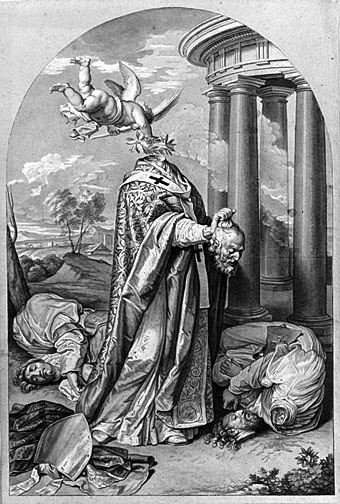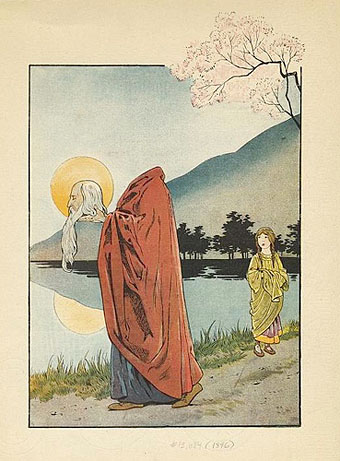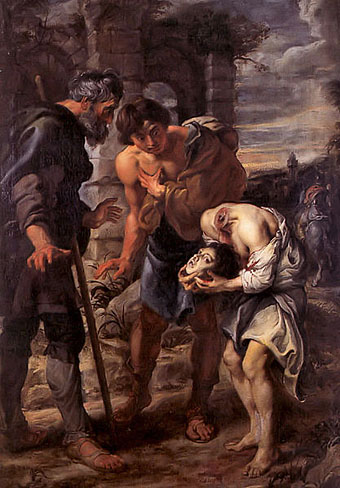
Martyrdom of Saint Denis, Saint Eleutherius and Saint Rusticus by Pierre II Mignard.
Consider this an addendum to an earlier post about decapitations in art history. What I didn’t know then was that decapitated saints have their own “cephalophore” category if they’ve been recorded as going for a post-decapitation stroll; a case of “take up thy head and walk”. Saint Denis of Paris receives more attention than most on account of his being a patron saint of France. This also explains why his martyrdom is depicted in gory detail on the wall of the Pantheon in Paris.
St. Denis bearing his head and halo (1896).
Nine-year-old Saint Justus of Beauvais differs from the strolling cephalophores—who manage to walk some distance before finally expiring—in having picked up his head severed head and carried on speaking. Rubens is one of the few artists to depict this event, although his habitual all-shall-have-muscles technique makes the boy look a lot older. Wikimedia Commons has a few more examples of Saint Denis, with and without head.
The Miracle of Saint Justus (c. 1635) by Peter Paul Rubens.
Previously on { feuilleton }
• Decapitations



They Might Be Giants have a song about a cephalophore
https://www.youtube.com/watch?v=anWrcmKsYI8
There is an interesting essay by Eric Basso in his book, Decompositions, about art and the depiction of severed heads. It is titled “Some severed heads”.
Paul loses his head http://images.dangerousminds.net/uploads/images/beatles_abbey_road_1969.jpg
Turn me on, dead man.
I like the question of where to put the halo. One finds pretty much all permutations, even with doubled heads and halos (https://twitter.com/Nicolam777/status/506763301679009792).
Some more relevant recent publications:
And They Were Two In One And One in Two: http://www.amazon.com/They-Were-Two-One/dp/1494701235/
Heads Will Roll:
http://www.amazon.com/Heads-Will-Roll-Decapitation-Imagination/dp/9004211551
;-)
Halos originated as a nimbus of light around the head so I’d always opt for keeping them with the head, attached or not. Those books look interesting. Eugene Thacker sent me a copy of In the Dust of This Planet, as it happens.
Makes sense. Cf. “the souls of the beheaded” (animas decollatorum) already represented in Revelation. In the Heads Will Roll book I suggest — via Huysman’s “L’horrible tête flamboie, saignant toujours” — a phenomenal relation between the halo and the aura of beheading itself. See http://books.google.com/books?id=ucgyAQAAQBAJ&lpg=PA22&ots=4Lhy45zAYy&dq=horrible%20tete%20flamboie&pg=PA22#v=onepage&q&f=false
;-)